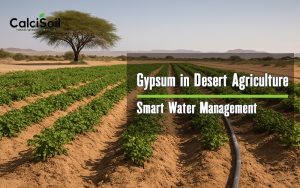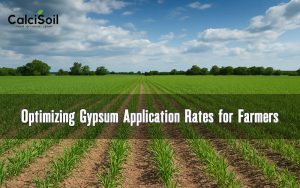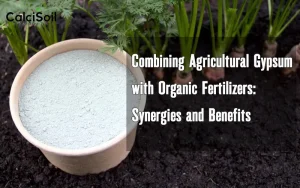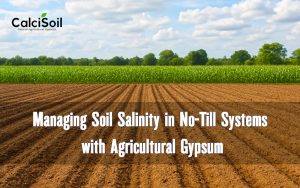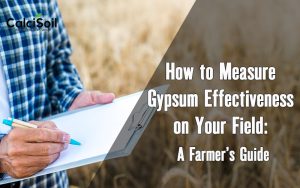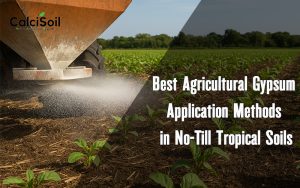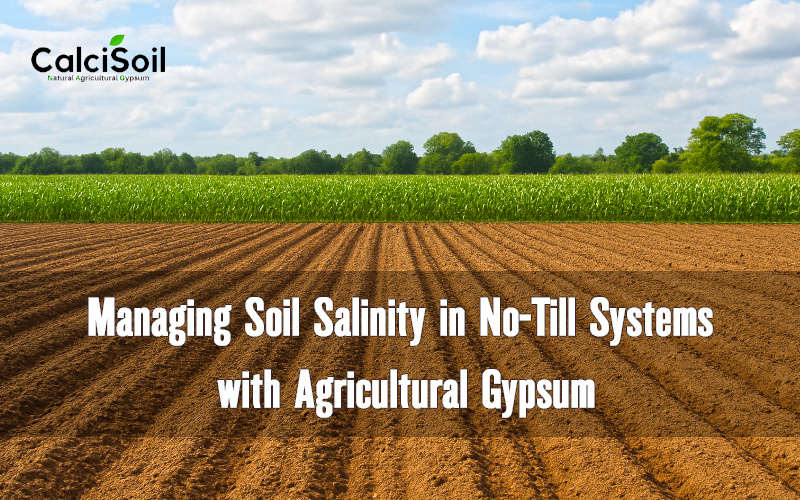
Understanding the Challenge of Managing Soil Salinity
Soil salinity is one of the most persistent obstacles farmers face in maintaining productivity, especially in semi-arid and arid regions. Salts accumulate over time due to irrigation practices, poor drainage, or natural soil composition. In no-till and reduced-tillage systems, where soil disturbance is minimized, managing salinity becomes even more challenging. Farmers cannot rely on mechanical mixing to redistribute salts, so chemical and biological amendments become essential tools. This is where agricultural gypsum plays a vital role.
Why Gypsum Works Against Salinity
The effectiveness of gypsum fertilizer in managing soil salinity comes from its chemical composition. Gypsum is calcium sulfate dihydrate, which provides soluble calcium ions. These calcium ions displace sodium ions that dominate sodic soils. As sodium is replaced, it can be leached away with irrigation water, reducing the harmful effects of high sodium levels on soil structure. Unlike other amendments, gypsum does not change soil pH drastically, making it safer for long-term use in sensitive cropping systems.
Benefits in No-Till and Reduced-Tillage Systems
In conservation farming practices like no-till, the soil surface is preserved to prevent erosion and improve organic matter content. However, this also limits the options for deep incorporation of amendments. The advantage of agricultural gypsum is that it is highly soluble and can infiltrate soil layers with water movement. Even without tillage, gypsum can move downward, correcting sodicity and reducing surface crusting. Farmers adopting no-till often notice better seedling emergence and stronger root growth after consistent gypsum applications.
Improving Water Infiltration and Root Growth
Saline-sodic soils are notorious for poor water infiltration. Sodium causes clay particles to disperse, creating compacted, impermeable layers. By applying gypsum fertilizer, calcium flocculates clay particles, opening soil pores and allowing better water movement. This is especially important in reduced-tillage systems, where natural soil structure is preserved but needs enhancement to support deep root penetration. Crops like wheat, corn, and soybeans often show dramatic improvement in drought resilience when gypsum reduces soil compaction.
Environmental Benefits of Gypsum Application
Beyond yield improvements, gypsum also contributes to environmental sustainability. High salinity and sodicity often lead to nutrient runoff and poor water quality in nearby streams. Gypsum stabilizes soil aggregates and reduces phosphorus losses, helping farms meet water quality regulations. In no-till systems, where surface residue protects against erosion, gypsum further enhances the system’s ecological benefits by keeping nutrients where they belong—in the soil.
for more information about gypsum effect on yields read the article “How to Measure Gypsum Effectiveness on Your Field: A Farmer’s Guide“.

Practical Guidelines for Application
To get the most from gypsum in saline soils, farmers should base application rates on soil tests. A common recommendation is one to two tons per acre, but requirements vary depending on sodium levels and soil texture. In no-till fields, surface application is often sufficient because rainfall or irrigation carries gypsum downward. Regular monitoring is essential; annual soil testing can reveal whether salinity and sodium adsorption ratio (SAR) are decreasing over time. Unlike quick-release fertilizers, gypsum’s benefits accumulate gradually, making consistent application part of a long-term soil health strategy.
Economic Considerations for Farmers
Many growers wonder whether the cost of gypsum fertilizer is justified. In most cases, the return on investment becomes clear after a few growing seasons. Improved yields, better water efficiency, and reduced need for corrective tillage translate into lower overall costs. Additionally, gypsum helps prevent crop failures in highly saline soils, offering insurance against productivity losses. When compared to other soil amendments, gypsum remains one of the most cost-effective solutions for sustainable salinity management.
Long-Term Outlook for No-Till Systems
As climate change intensifies water scarcity and soil stress, tools like gypsum will become increasingly valuable. No-till and reduced-tillage systems are already key to sustainable farming, but their success depends on maintaining soil structure and fertility. With gypsum as part of the strategy, farmers can address salinity while preserving the benefits of conservation agriculture. Over time, this approach builds resilient soils capable of supporting higher yields and reducing environmental impacts.
Conclusion
Managing soil salinity in no-till and reduced-tillage systems is a complex challenge, but agricultural gypsum offers a proven and practical solution. By improving soil structure, displacing harmful sodium, and enhancing water infiltration, gypsum creates a healthier root zone for crops. Farmers who integrate gypsum into their fertility programs not only improve productivity but also secure long-term sustainability for their land. As agriculture moves toward more climate-smart practices, gypsum fertilizer remains a reliable ally in building resilient soils.

